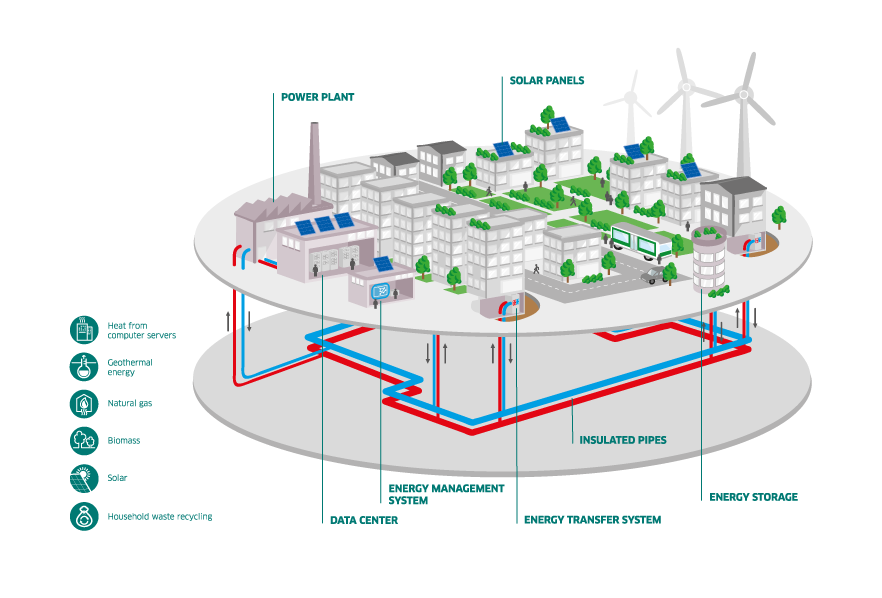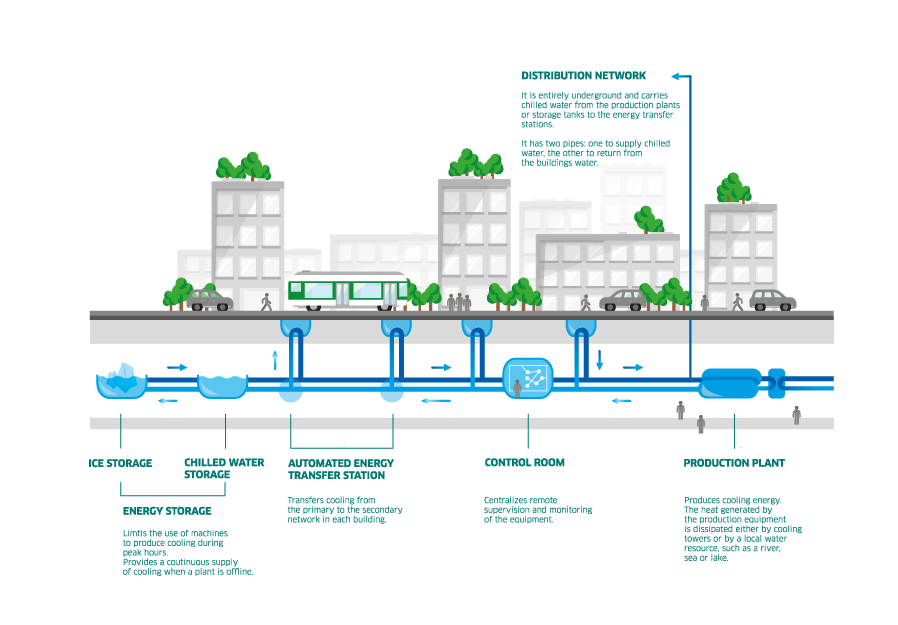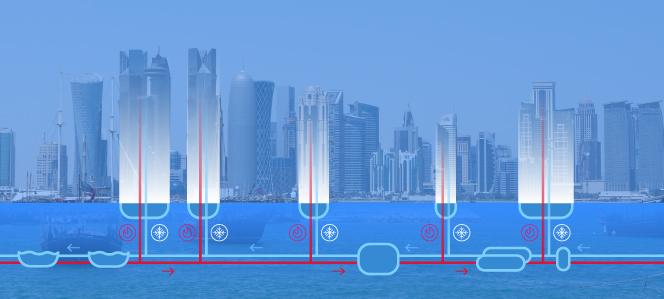How do you heat or cool a neighborhood or an entire city at the same time as reducing its CO2 emissions? By using urban heating and cooling systems!
Find out more about ENGIE expertise in this market.
Providing comfort with space heating or conditioned air to everyone in commercial offices, community housing projects, industrial buildings and public facilities, at the same time as cutting CO2 emissions... That’s the mission of the urban heating and cooling networks designed, built and operated by ENGIE.
Needs differ from place to place, our capability and expertise contribute to delivering solutions tailored to local needs. Decentralized generation that blends into the urban landscape and incorporates energy from renewable sources, including biomass, geothermal, waste industrial heat reclamation, etc. The sea, rivers and lakes can also be used as sources of fresh and cooling water, and therefore contribute to cooling service-sector and public buildings. ENGIE’s goal is to increase, from 2018, the contribution of renewables to 50 % in all its European urban networks onwards.
Heating all the buildings in a neighborhood or an entire city
A heating network generates and distributes heat in the form of hot water and superheated steam using one or more generating units. They generally uses a range of different primary energy sources for heat generation, including natural gas, locally-generated energy and renewables in the form of household waste incineration, biomass (wood, etc.), biogas, solar, geothermal and heat recovered from wastewater.
A heating network has four main component parts:
- one or more heat generating units,
- a primary pipeline network that transfers the heat to the delivery points,
- Heat exchanger substations installed in connected buildings,
- a secondary pipeline network that distributes the heat in the form of hot water from the delivery points (substation) to the radiant sources in individual homes or offices.

Delivering conditioned air services to buildings connected to a central cooling network
A cooling network is a centralized system that provides chilled water to supply an air conditioning system. In practice, it includes chilled water production and distribution facilities to provide cooling services to all connected buildings. Operating as a closed circuit, the cooling network always includes two pipelines: one supplying chilled water to users, and the other returning the water to the production plants.
The presence of a water source close to the network can make it possible to dispense with the need for a cooling tower at the production plant. Known as free cooling, this technique is used by CLIMESPACE, which abstracts around 50 % of its Paris cooling network needs from the river Seine.
Compared with a traditional air conditioning system, this network:
- consumes 35 % less electricity,
- emits 50 % less CO2,
- greater than 50 % energy efficiency,
- 65 % less water consumption.

ENGIE’s worldwide operating presence
ENGIE operates many heating and cooling networks around the world, including:
In heating:
- The city heating network designed, built and operated by ENGIE at Aosta in Italy recovers and recycles waste energy from a nearby steelworks. It's one of the most innovative systems in the country.
- In Bordeaux, the future Plaine Rive Droite geothermal heating network, for which ENGIE was awarded the 30-year public service outsourcing contract at the beginning of 2017, will use the natural heat of deep groundwater aquifers to meet 82 % of its needs. Two ENGIE subsidiaries - ENGIE Cofely and Storengy - are involved in the project to offer a seamless and integrated package that combines their respective expertise in heating networks and underground exploration.
- In the Paris region of France, the Saint-Denis biomass heating plant combines environmental protection with a mission to counter energy poverty. The greening of the Plaine Commune heating network - the 2nd-largest in the Paris region and the 3rd-largest in France - has developed consistently since the network first became operational in the 1950s to the point where more than 50 % of the energy it uses comes from renewable sources today. The use of biomass reduces annual CO2 emissions by more than 56,000 metric tons, which is equivalent to the annual emissions generated by 25,000 vehicles.
In cooling:
- The cooling network operated by ENGIE in the city of Paris is one of the most extensive in the world: it is cooled by water from the river Seine, and makes a valuable contribution to keeping the city cool in the summer months. Better still, energy efficiency is improved by 50 %, with a proportionate reduction in CO2 emissions
- In Malaysia, ENGIE contributes to providing cooling services for 40 buildings in the city of Cyberjaya - with its concentration of new tech companies - with an urban cooling plant that reduces energy bills by 15 %.
- In the Philippines, ENGIE is part of a joint venture operating a central water cooling plant that provides cooling services to 10 buildings of the Northgate Cyberzone information technology park in Greater Manila. This cooling network delivers a 35 % gain in energy efficiency, has reduced annual CO2 emissions by more than 11,000 metric tons, and cut energy consumption by 13 %.
- In the USA, ENGIE and its partner Axium have won a 50-year outsourcing contract to provide sustainable energy management services to the Ohio State University, one of the largest university campuses in the country, with 485 buildings. The contract covers the operation and optimization of all its energy generation and distribution infrastructures (1 steam network, 3 cooling networks and gas and electricity supply systems).
In heating and cooling:
- In Marseille, three ENGIE subsidiaries (ENGIE Cofely Climespace, ENGIE Ineo and ENGIE Axima) have developed a new solution that uses a very local source of renewable energy: the heat energy content of the Mediterranean Sea! Located at the Grand Port Maritime de Marseille, the Thassalia marine geothermal plant is the first in France and the wider Europe to use marine thermal energy to provide heating and cooling for all the buildings connected to its network - a combined footprint of 500,000 m2 ultimately - at the same time as reducing greenhouse gas emissions by 70 %.
- In Spain, ENGIE operates the country’s first heating and cooling network: Districlima in Barcelona, which recover the heat generated by household waste processing for re-use as heat for a heating network and to produce chilled water. The network supplies 94 buildings.
- In Lisbon, the heating and cooling network operated by Climaespaço is famous for being the first city-scale centralized thermal energy distribution network. It has reduced the capital’s annual CO2 emissions by 40 %, and serves 130 buildings.



